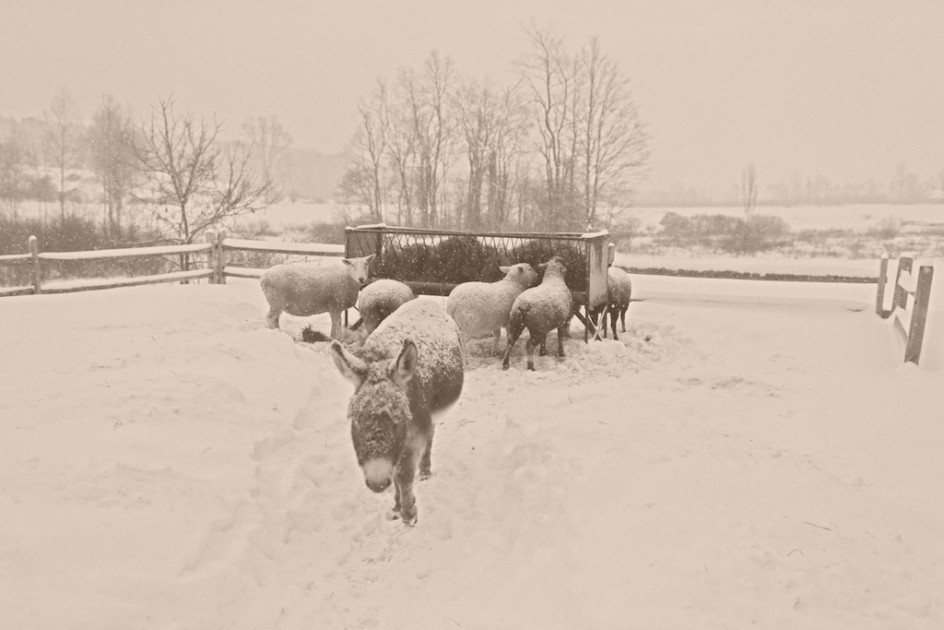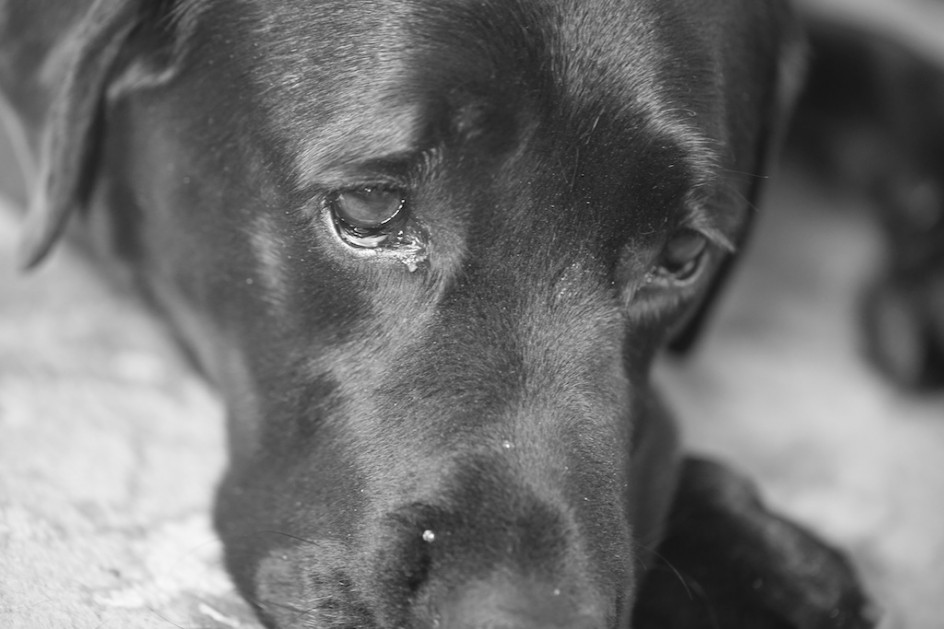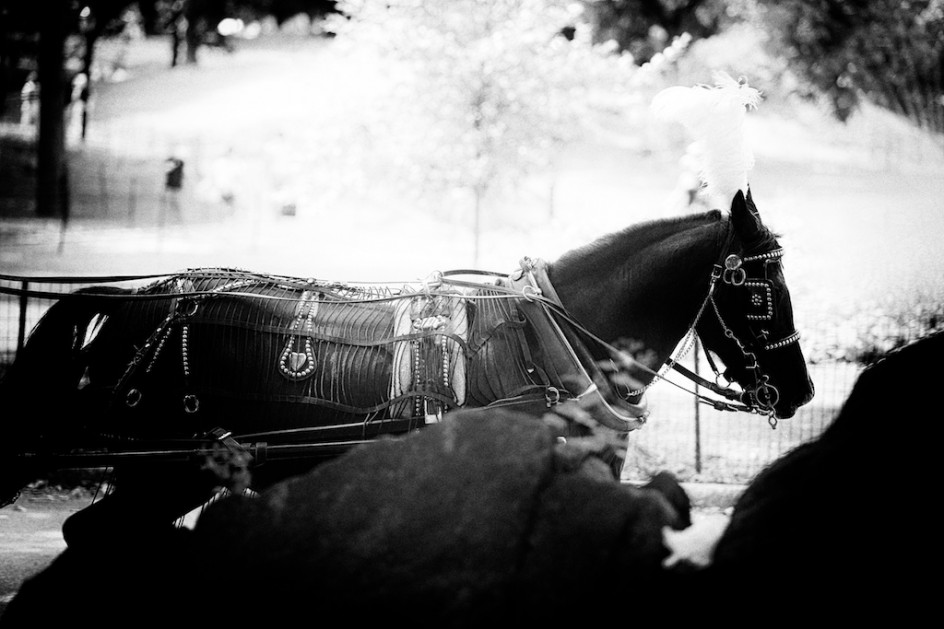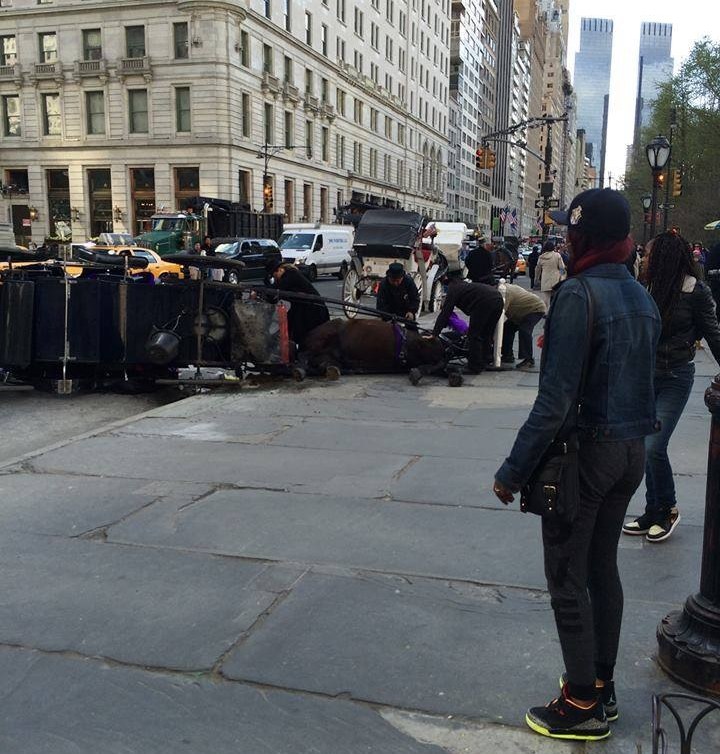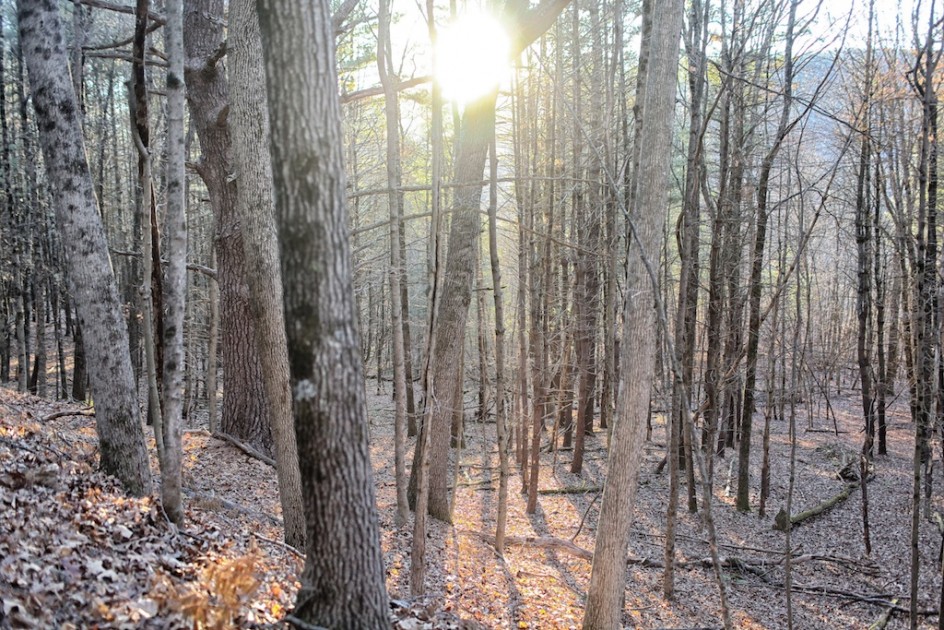
I was inspired to finally write this yesterday, when I looked out of my study window and saw a young, bearded man in jeans crawling around my back yard, peering into the windows and doors. He looked like somebody in the movie Goodfellas.
I thought he was a sales person, or someone eager to talk religion.
In the morning, I close my study door, Red is always at my feet. I do not answer the phone or the door. I write. The tapping at the door became pounding, aggressive and insistent, I got up, irritated, and then saw this man – he looked furtive and angry – heading towards the back of the house where Maria’s studio is.
Something about him did not look right to me.
I went to the door, opened it and called out to him, asking if I could help.
He asked if I was Jon Katz. I said I was, and he threw some papers on the ground. “You are served,” he said, and then, seeing Red (who was wagging his tail), he moved quickly back to his car and drove off. I wish Frieda had been there. I felt I was in a movie, I had been notified of a lawsuit against me by a bank seeking payment on a loan for the first Bedlam Farm. The paperwork said the bank was suing me, coming after my assets, seizing collateral, the elements of Bedlam Farm.
I called our lawyer, he said it was a mistake. The bank had not been notified about the bankruptcy proceedings Maria and I had entered into in August, or they lost the paperwork. The debt had been cleared. They should not have been sending anyone to serve me papers or be threatening me. The bank said today they didn’t know, they apologized, they said they will withdraw the suit. This is a new kind of story, for me, my blog and my life. It is time I shared it.
One day, it will be a funny story to tell: Another scene in my life that I could never once have imagined. Time to come out in the open.
I knew I had to share the fact that Maria and I declared personal bankruptcy in the late summer, the courts just released us last week. As you know, I am committed to being open, to sharing my life but my lawyer said bankruptcy was not a smart thing to share until it was over. In a way, it is not ever over, as me and the bank that sent the process-server will learn this week. But the legal part of the bankruptcy is over, our debts have been discharged by the federal courts.
In all of my life, I never once imagined I would ever file for bankruptcy. I believe in paying my bills, I meet my obligations, I value my word. When I borrow something, I always intend to pay it back. I always have.
From the time I was 17, I never had any problem earning a living, making money. I have always worked and worked hard, I have always been successful. I could hardly imagine this trouble. This, I learn, is not an uncommon thing these days. Many people know it.
I was always immensely proud of making a living as a writer, I still am. It is not an easy thing to do. But it wasn’t writing that sent me into bankruptcy, but a much broader spectrum of life: divorce, the Great Recession, the collapse of the real estate market, the drastic changes in publishing, our inability for four years to sell the first Bedlam Farm as we desperately fought to prevent foreclosure. How could so many difficult things happen to me at once? As our obligations and debts from two farms rose, my income fell. I gave most of my money away as part of my divorce. It was the right thing to do, and I don’t regret it.
Mostly, this was my problem, there were my struggles, my issues. But Maria and I married five years ago. Legally it was our problem now, and Maria embraced it without complaint. She is a wonderful human being, full of courage and warmth and decency. I cannot imagine going through this without her at my side.
We kept borrowing money to keep paying for two farms. We never imagined Bedlam Farm would not sell for four years, neither did our bank or realtor or anyone else on the earth. It was a beautiful place, I put most of the money I had into repairing and restoring the house and the barns and the grounds. This is the wonder of life – it has its own plans.
Then, and for four years, two mortgages, repairs, insurance on two farms, real estate ads, the costs of heating and winterizing, plowing and mowing, roof and painting repairs, taxes and upkeep. Why didn’t I quit? I don’t know, perhaps because I am still a fool for emotion. All those books! Rose in the pasture, Orson on the hill, Jeff Bridges in the back yard.
I suppose I should have just let it go much sooner, but I couldn’t do it. The mortgage was an obligation, the farm was special to me – I had written eight books there, I came to life there, I went to pieces there – I could not see it fall into foreclosure. And we did save the house from foreclosure until some good people bought it last year. They bought the house about half of what we first tried to sell it for. The bank got the money.
It wasn’t until earlier this year that we finally came to see that there would be no big book or miraculous windfall to save me, no saviors or angels or farm lovers to rescue me, not St. Joseph statues or chants or Karma to bring the right buyer to us. The house was not going to sell for anything close to what it was worth or that I had put into it or that we had been asking for it. We kept waiting for the world to come back to normal, but it hasn’t come back to normal, it may never. Too late, we realized we could not possibly pay back all the money we had borrowed to keep the first farm and our new farm operating. We had dug a huge hole for ourselves and jumped in.
Both were mortgaged to the same bank, they were tied together. We were in danger of losing our second home as well if we could not pay the loans and shortfall accrued by the first. I remember the moment, month after month of worry and uncertainty, scrambling to pay one bill, and then the other. Our resources melted, then rushed, away. Finally, I turned to Maria. “We can’t do this anymore,” I said. “We have to let it go.” By then, we owed a great deal of money.
So we finally asked for help. We went to see a very fine young lawyer in Glens Falls, New York His name was Edwin Adeson, and he said we ought to file for personal bankruptcy and remove this debt. We agreed.
Maria can take care of herself. She is tough and strong, but I have been much haunted – especially after my open heart surgery – by the idea that she might be left with my debts and my problems after I am gone. She is likely to live without me, I am 17 years older than she is. She bristles when I say this, she married me knowingly, she said, she can take care of herself.
I know she can. But that doesn’t stop me from worrying about it. She had nothing to do the purchase of the first Bedlam Farm or the effort to sell it. These were not her debts.
I was determined to shed as much of this as I could legally and morally do. So we filed for bankruptcy in August, the bankruptcy period ended before Thanksgiving. Oddly, the only beautiful thing about it was that we did it together, every step of the way. On that sunny day in August, we held hands as we walked up to the federal office building in downtown Albany and hugged. We smiled and kissed. Another chapter, I said.
I won’t lie. My heart was broken that day, here in a place I never expected to be.
Ed Adeson was to guide us through this turbulence with clarity, honesty and grace. We came to much appreciate him. Sometimes, I think that lawyers are the only people who can navigate in this world. Ed is an advocate for people without money.
In this period, we began negotiations with our bank to keep our home, and it was not clear how that would turn out. Now, it appears they have been successful. It seems we will be able to stay in our new farm. We were fortunate to have a bank that wanted to work with us, and did work with us. So many people are not so fortunate. We reached an agreement we can live with. For many months, I wasn’t sure, it was a heavy cloud to be hanging over us. I remember thinking at our crowded and happy Open House in October that this might be the last one ever, the last time people could share our life there. It will not be the last, we will have the next Open House in June.
The bankruptcy transformed us in many ways. In my early life, bankruptcy was unimaginable, a disgrace, something whispered about by the gossips at the dinner table. I had an uncle who killed himself rather than declare bankruptcy. It was a great shame on men who were supposed to provide for their families – that was their mission and purpose in life. Bankruptcy hit my ego and my pride, my conscience and sense of self as a worthy and successful person.
How had it come to this?
My brother and I have had a difficult relationship, we barely spoke all of our lives and barely spoke now. But during one of our rare conversations as these troubles mounted, he told me not to blame myself. “You got caught in some storms all at once.” it was the only helpful thing he ever said to me, so it stuck. It is true, I repeat this to myself all the time. It is not my fault. I was hit by storms. Still, shouldn’t I have foreseen this, or forestalled it?
We were relieved by the bankruptcy once it was done. We went to a courtroom in Albany, sat before a bankruptcy change and swore that we weren’t hiding anything. We aren’t. We don’t have anything to hide, really. That is the liberating part of bankruptcy.
It isn’t so bad. No big vacations, no fancy restaurants, no expensive holiday gifts. No credit cards. Life goes on, even with a mangled credit rating. We will get it back, if it matters.
Honesty and acceptance are gifts, we had been carrying a load we could not possibly bear. I remember those nights when we would go over the bills and figure out how $200 was going to last us a couple of weeks. I am so sorry, I wanted to say to Maria. I am so sorry. But I only said it out loud once, it made her furious. Don’t ever apologize to me, she said. I had my eyes open, it was not your fault.
Maria is a miracle to me. I did not know people like this existed in the world. Our love for one another was greatly and powerfully affirmed. We supported one another, comforted one another, reassured one another. There was not one moment of blame, recrimination, or panic. Our love is more powerful than any circumstance we might face. We had quite a few bad moments, none had to do with one another. It never pulled us apart, it brought us closer.
I gave up all of my credit cards, as required in bankruptcy, and I am happy to say that I don’t miss them. I don’t think I will get any more, even when I can (the mail offers for new credit cards for post-bankruptcy people – high interest rates, low limits – are already coming in). But my idea about money has changed. There is something quite liberating about learning to only acquire what one had the money to buy. This has altered my life, and in a good way. This is how the old farmers live, I see why.
And this is America. There is always someone willing to sell you anything.
We are closer to the end than the beginning. We were often frightened, we often looked at each other seeking reassurance. Would it be all right? Could we get through it? Could we heal and recover? We’ll be fine, this was our mantra. I hope that’s true. I am 68 years old, one year out of open heart surgery, no money in the bank. My world tells me every day that this is catastrophic place to be, but it is my place to be and the right place for me to be.
Bankruptcy was a beautiful and uplifting time in so many other ways. One does learn the power of love and friendship. I think Maria and I both acquired a strength and determination we perhaps did not know we had. We learned to shed shame and guilt and stand up and be proud, to get busy and back to work. We told all of our friends, we hid nothing from anyone. The world did not come to an end, people were surprised, but no one ran away from us.
We will heal and be whole. Absolutely. We faced some powerful demons this year, inside and out. We acted honestly and honorably. We were faithful to one another, and our own sense of self. We stood in our truth. We never said or did one dishonest thing, or said or did one thing we are sorry for. When we need to be strong, we were.
It was, at times, a lonely thing. Maria and I are not close to our families, we did not have people to call, or people who would call us. We felt very much on our own. Lots of paperwork, a million lawyerly questions, scores of forms to fill out. What do you own? What have you owned? What do you spend? We had to take a four-hour online course about money and responsibility. You had to stay on for two hours at time, even if you were done in ten minutes. There was a quiz. What is a budget? Do you really need a cellphone? How do you balance what you earn with what you need? But wait, I wanted to say. This isn’t me. I don’t need to be lectured or patronized. I’m not teenager with a credit card problem. I know all this. This isn’t helpful to me. This is the last place I want to be. I don’t even own a TV. I don’t have a spending problem. I got divorced. I had a farm…
There was no one to tell.
It was sometimes a rocky path to bankruptcy. There were weeks when we did not have money for grocery shopping, we ate carefully, budgeted ingenuously. There were days when bill collectors called with bullying voices and threats, and often, with many lies. They threatened us, tried to frighten us, made trick phone calls pretending to be friends and helpers. We were called to be strong, to have faith.
We did, we were.
Every day the mail brought warnings, threats, demands, letters from lawyers. Every single time I had to resist the powerful temptation to pick up the phone and call them back: no, no you don’t understand, I’m a good man, a responsible man, an ethical man. I don’t belong in this situation. You don’t need to be talking to me, this way. Sometimes I did pick up the phone, and ended up being yelled at, insulted, bullied. None of them ever did want to talk to me, or listen to me. You owe this money! You have to pay! How naive could I possibly be? But the old self dies hard, the old delusions leave their marks, their imprints. I hung on to my other life until it seemed absurd, even humiliating.
I learned an interesting thing about the system of money and credit. If you have nothing, you have nothing to lose. We had nothing to lose.
For so many years, I thought bankruptcy and financial struggle was something other people go through, somehow they were different from me, apart from me, something other than me. I can tell you that I was wrong about that. Where, after all, do empathy and perspective really come from? All those politicians so contemptuous of the weak and the poor, they simply have no idea what it feels like. I am better, wiser. And luckier. I got a good lawyer, I had resources and experience, I was in so much better a position than so many others who are in it.
As it turned out, the banks and credit card companies didn’t care that I was a New York Times best-selling author, that a movie had been made about me, that publishing had changed, that my royalty checks had disappeared. That I was caught in a bunch of storms. That I paid every one of my bills for more than half-a-century without ever missing one of them. I gave them all so much money. It didn’t matter, and I knew it didn’t matter. And why should it?
No need to mention that you were an author, said the lawyer. Tell them you’re a blogger. But I am an author, I said. Nobody cares.
It was a humanizing experience, full of empathy and awareness. I like to think I have always felt for the poor, but I see them in a new and more generous way. A more conscious way. I see many things in a different way. In a sense, we are all poor, or easily could be. They must be given hope. They are no different from me, most are much worse off than me. The system is rough and Darwinian, even for good people who follow all of the rules. In the Corporate Nation we are taught to pay our bills, it is the rationale for life. But the irony is that Maria and I are good people who follow all of the rules. I never missed a payment for anything my entire life until this year. But I will always be more conscious of the trouble that people can slip into, and of the system that is so tricky, so merciless and dehumanizing when problems arise.
I want to say this to other people: we are can all get caught in storms. Our culture is not forgiving about suffering and struggle. But there is no reason for shame, there is nothing to apologize for. If it could happen to me, it could happen to you, and I would share this with you: the challenge is not in avoiding trouble, the challenge is how we respond to it. That is grace. I am very proud to say that Maria and I responded to it well. We were often frightened, often confused, sometimes we felt very alone. We did not bend or break. Do not blame yourself.
And we are better for it, wiser, happier, more at peace with ourselves. Love is so often about letting go, and for me, bankruptcy was about letting go of a certain idea about who I was, and who other people are. We are better now, much of the storm has passed, the waters are calming. We can buy groceries, fill up the car without much thought. When the septic tank needed $1,000 of work last week, I was briefly terrified. Not of the tank, but of the cost. Could we do it? Could we do anything else if we do it? Welcome to the real lives of real people. There is always an elephant in the room in the world of bankruptcy.
Maria and I have a lot of work to do be whole again, we will do it, we will get there. We are together, we are healthy, we are determined, we have gifts and missions. The calls have stopped, the letters have stopped, I think there will be no more creepy men in the garden.
I try to reconcile this: not so long ago, I had plenty of money, I was miserable and fearful and angry. Today, I have very little money. I have never been happier. I have never been healthier. I have never felt better about myself or my life. I have never had more love, or done better work, or loved it more. I have a book coming out next year, I hope to start work on another one. My blog has never been stronger or more meaningful to me and others.
Money is important, we do all need to pay our bills. We cannot live lives we cannot pay for. But other things are important, too. Security does not come from money, neither does safety or well-being. That comes from the inside, nobody can give it to me, nobody can take it away.
Maria and I both experienced some shame, fear, vulnerability and much worry this year. We were bankrupt. Never in my life did I ever have to wonder if I would have a place to live, or how I could eat. We worried so much about the animals – the donkeys, the dogs, chickens, cats and a pony. What would become of them if we lost this farm too? Who would care for them? How would they fare if they had to be without us. This was an awful thing to think about. How would they ever understand it?
And then, this: People kept telling me my writing was different, more open, more intuitive. I bet. Writers are only as good and compelling as their lives. I learned a lot this year, experienced much, even about having a creepy-looking man crawling around my garden to serve me with papers.
So I knew I had to write this, not only to be honest and tell you that I had declared bankruptcy, but also to tell you that I have never been richer or more blessed. More to come. Of course, I’m doing a Recovery Journal about it. That is what I do.
That is life, I think. Crisis and mystery, just around the corner.

